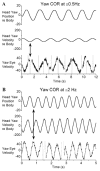Modification of the cervico-ocular reflex by canal plugging
- PMID: 19645881
- PMCID: PMC5004727
- DOI: 10.1111/j.1749-6632.2009.03775.x
Modification of the cervico-ocular reflex by canal plugging
Abstract
The cervico-ocular reflex (COR) has a low gain in normal animals. In this study, we determined whether COR gain increases were specific to the low/midband frequency range, which is the range over which the angular vestibulo-ocular reflex (aVOR) is compromised by plugging. The gain and phase of the yaw and pitch COR and aVOR were compared in normal monkeys and those with all six semicircular canals or only the lateral canal plugged. During experiments animals sat with the body fixed to a chair and the head fixed in space. The body was oscillated about body-yaw and body-pitch axes over a frequency range of 0.05-6 Hz, with amplitude <10 degrees. For normal animals, both yaw and pitch eye velocities were compensatory to the relative velocity of the head with respect to the body. The gains were 0.1-0.2 at frequencies below 1 Hz and decreased to zero as stimulus frequency increased above 1 Hz. Canal-plugged animals had COR gains close to 1.0 at low frequencies, decreasing to approximately 0.6 at 0.5 Hz and to 0.2 for stimulus frequencies above 3 Hz. The phase of eye velocity was 180 degrees relative to head-re-body velocity at frequencies below 0.5 Hz and shifted toward 270 degrees as frequencies were increased to 4 Hz. This study demonstrates that adaptation of COR gain is tuned to a frequency range at which the aVOR is compromised by the canal plugging.
Conflict of interest statement
The authors declare no conflicts of interest.
Figures




Similar articles
-
Complementary gain modifications of the cervico-ocular (COR) and angular vestibulo-ocular (aVOR) reflexes after canal plugging.Exp Brain Res. 2011 May;210(3-4):549-60. doi: 10.1007/s00221-011-2558-6. Epub 2011 Feb 1. Exp Brain Res. 2011. PMID: 21286691 Free PMC article.
-
Dynamics and kinematics of the angular vestibulo-ocular reflex in monkey: effects of canal plugging.J Neurophysiol. 1998 Dec;80(6):3077-99. doi: 10.1152/jn.1998.80.6.3077. J Neurophysiol. 1998. PMID: 9862907
-
Semicircular canal contributions to the three-dimensional vestibuloocular reflex: a model-based approach.J Neurophysiol. 1995 Dec;74(6):2722-38. doi: 10.1152/jn.1995.74.6.2722. J Neurophysiol. 1995. PMID: 8747227 Free PMC article.
-
Changes in the vestibulo-ocular reflex after plugging of the semicircular canals.Ann N Y Acad Sci. 2001 Oct;942:287-99. doi: 10.1111/j.1749-6632.2001.tb03753.x. Ann N Y Acad Sci. 2001. PMID: 11710470
-
Adaptation of primate vestibuloocular reflex to altered peripheral vestibular inputs. I. Frequency-specific recovery of horizontal VOR after inactivation of the lateral semicircular canals.J Neurophysiol. 1996 Nov;76(5):2941-53. doi: 10.1152/jn.1996.76.5.2941. J Neurophysiol. 1996. PMID: 8930246
Cited by
-
Progress toward development of a multichannel vestibular prosthesis for treatment of bilateral vestibular deficiency.Anat Rec (Hoboken). 2012 Nov;295(11):2010-29. doi: 10.1002/ar.22581. Epub 2012 Oct 8. Anat Rec (Hoboken). 2012. PMID: 23044664 Free PMC article. Review.
-
Complementary gain modifications of the cervico-ocular (COR) and angular vestibulo-ocular (aVOR) reflexes after canal plugging.Exp Brain Res. 2011 May;210(3-4):549-60. doi: 10.1007/s00221-011-2558-6. Epub 2011 Feb 1. Exp Brain Res. 2011. PMID: 21286691 Free PMC article.
References
-
- Mandellos D, Anastasopoulos D, Becker W. Smooth pursuit rather than visual signals mediate short-term adaptation of the cervico-ocular reflex in humans. Exp Brain Res. 2006;169:153–161. - PubMed
-
- Huygen PL, Verhagen WI, Nicolasen MG. Cervico-ocular reflex enhancement in labyrinthine-defective and normal subjects. Exp Brain Res. 1991;87:457–464. - PubMed
-
- Böhmer A, Henn V. Compensatory eye movements during high angular accelerations in the monkey. Adv Otorhinolaryngol. 1983;30:174–176. - PubMed
-
- Baker J, et al. Oculomotor reflexes after semicircular canal plugging in cats. Brain Res. 1982;252:151–155. - PubMed
-
- Bárány R. Augenbewegungen durch Thoraxbewegungen ausgelöst. Zentralbl Physiol. 1906;20:298–302.
Publication types
MeSH terms
Grants and funding
- R01 DC009255/DC/NIDCD NIH HHS/United States
- DC2390/DC/NIDCD NIH HHS/United States
- EY11812/EY/NEI NIH HHS/United States
- EY04148/EY/NEI NIH HHS/United States
- DC09255/DC/NIDCD NIH HHS/United States
- R01 DC002390/DC/NIDCD NIH HHS/United States
- DC04996/DC/NIDCD NIH HHS/United States
- R01 DC004996/DC/NIDCD NIH HHS/United States
- R01 EY011812/EY/NEI NIH HHS/United States
- P30 DC005204/DC/NIDCD NIH HHS/United States
- DC05204/DC/NIDCD NIH HHS/United States
- R01 EY004148/EY/NEI NIH HHS/United States
- EY01867/EY/NEI NIH HHS/United States
- P30 EY001867/EY/NEI NIH HHS/United States
LinkOut - more resources
Full Text Sources
Research Materials

